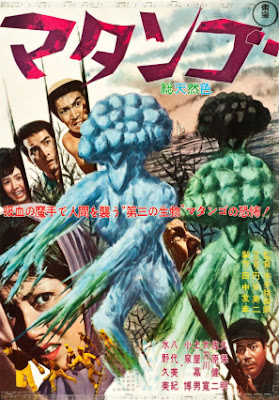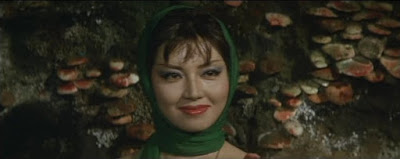Jigoku (1960) Many
films about hell make promises about what you might see, but few deliver. Jigoku is a rare exception that doesn’t
pull its punches in its sordid depictions of the Buddhist underworld. Shirô (Shigeru
Amachi) is a young college student, engaged to marry the daughter of one of his
professors. One night, while driving home from her house, he hits a drunken man
who wandered into the road. Instead of stopping to help, he drives away,
leaving the man to perish. Soon afterward, one tragedy after another befalls Shirô.
All the while, he’s plagued by Tamura (Yôichi Numata), a strange man who
represents his conscience.
Director/co-writer Nobuo Nakagawa creates a dizzying
experience, full of symbolism throughout to depict Shirô’s inexorable descent.
The film features inventive set design and art direction, which illustrate the
numerous torments of Buddhist hell. As Shirô navigates the horrific, gory
landscape, he visits different levels where justice is meted out in a manner
commensurate with each crime. It’s an unforgettable, unsettling trip.
Rating: ****. Available on DVD
Haruko’s Paranormal
Laboratory (2015) I really wasn’t expecting much from Haruko’s Paranormal Laboratory, which appears to have been shot for
less than $500, but ended up pleasantly surprised. This charming comedy/fantasy
from writer/director Lisa Takeba focuses on Haruko (Moeka Nozaki), a lonely
young woman who becomes so involved with her television shows that her TV turns
into a man (Aoi Nakamura). Haruko ponders her new dilemma, as she pursues an
unconventional romance with her new boyfriend. Takeba’s film is an absurd
commentary about how the lives of people on television become more real to us
than the outside world (the TV brand is “Videodrome”). Much like the films of
Mamoru Kawasaki, you get used to the fact that there’s a guy with a TV head,
and move on. There’s also a freak show, space aliens and a Jason cosplayer. How
does it all fit in? You’ll just have to wait and see.
Rating: ****. Available on Amazon Video
Paprika (2006) The
late, great director Satoshi Kon had far too few feature films to his credit, but
left a lasting impression on the anime world. Paprika concerns a revolutionary invention, the DC Mini, a headset that
enables someone to enter another’s dreams. The device is intended for
psychological research and therapy, but after one of the headsets goes missing,
it’s clear that it can be twisted into something that can harm. A psychological
researcher (assisted by her alter-ego, “Paprika”), a police investigator, and
the childlike genius who invented the DC Mini combine forces to locate the
errant device. Meanwhile, the dream world and reality collide with increasing
frequency. Filled with mind-bending images and a thoughtful story, Paprika is a feast for the eyes, best
experienced, rather than described
Rating: ****. Available on Blu-ray and DVD
Belladonna of Sadness (1973)
Eiichi Yamamoto’s visually stunning, tragic tale is unlike any other anime film
I’ve seen. The film lives up to its title, depicting the story of a young woman
who’s raped by a sadistic king on her wedding night, and continues to
experience a cascade of tragic events. She finds a way to climb up in status, only
to be shunned by the kingdom and her fellow villagers. She’s seduced by the
devil, who promises her prestige and the power to heal, but at a terrible
price. Yamamoto incorporates multiple styles to illustrate the heroine’s
personal journey, as she explores her sexuality, and uses sex as her only
leveraging tool. It’s a meditation on gender inequality and social injustice
that seems more relevant than ever.
Rating: ****. Available on Blu-ray, DVD and Amazon Video
Pitfall (1962) Director
Hiroshi Tehigahara’s (The Face of Another,
Woman in the Dunes) debut feature
film paints a bleak portrait of industrial Japan, and the human cost associated
with prosperity. An itinerant coal mine worker is mistaken for the leader of a
labor union, and murdered by a strange man in white. The ghost of the murdered
man wanders the countryside, trying to learn more about the man who killed him.
The local police conduct a fruitless investigation, while the sole witness to
the murder misleads them for her own gain. Pitfall
is visually compelling, with a neo-noir feel and a supernatural twist.
While I was captivated by the cinematography and themes, I felt distanced by
the characters. It’s fascinating to watch, but difficult to feel emotionally
engaged.
Rating: ***½. Available on DVD
Welcome to the Space
Show (2010) This beautifully animated film is a joy to look at, but the story
is a little weak, with its predictable “be yourself” and “follow your dreams” messages.
A group of kids in a rural town befriend a dog-like alien, who takes them on a
trip to the far side of the moon and beyond. The film works best when it
showcases the imagination of the animators – they really went above and beyond
to depict a broad spectrum of alien creatures. It’s also effective in some of
the quietest moments, when the characters have a moment to take a breath and
contemplate their surroundings. Too bad the climax is a standard overblown
action sequence, with a clichéd fight between good and evil. If you’re looking
for something the whole family can watch, however, you could do much worse. It’s
still light years ahead of most of the animated claptrap that comes out of Hollywood.
Rating: ***½. Available on DVD and Amazon Video
Big Man Japan (2007)
This unconventional mockumentary by director/co-writer Hitoshi Matsumoto chronicles
the everyday, often humdrum life of superhero Masaru Daisatô (also played by
Matsumoto). Nothing seems to go right for Daisatô, who’s 6th in a
line of superheroes, and faces sagging TV ratings, almost universal public
scorn, and a marriage on the skids. He becomes super-sized, thanks to a jolt of
electricity, and fights an increasingly bizarre lineup of monsters (including a
kaiju with a comb-over hairdo) that threaten the peace of Japan’s major cities.
Matsumoto approaches his character with pathos, and never makes the mistake of
pandering for laughs. Most of the film works so well that it’s disappointing
when things fall apart at the end. Instead of bringing some sort of resolution
to Daisatô’s story, we’re treated to an Ultraman-style
parody that seems tacked on. Caveats aside, the dubious conclusion shouldn’t
stop you from checking out a truly one-of-a-kind experience.
Rating: ***. Available on DVD
Twilight Syndrome: Dead
Go Round (aka: Twilight Syndrome:
Deadly Theme Park) (2008) I was playing
streaming roulette one night, and happened upon this silly fantasy/horror film
based on a video game series in Japan. A group of players are transported to a
deserted amusement park, and are forced to take part in a winner-take-all
competition. A weird clown (who looks like the love child of Ronald McDonald
and Ryuk from Death Note) presides
over the action, and serves as judge, jury and executioner. Each participant must
complete a goal in order to reach the next level, with death the penalty for
failure. The players are stereotypical archetypes (the obese geek, the brooding
loner, the fashionista, etc…). It all adds up to a conclusion that doesn’t make
a lot of sense, but conveniently sets things up for a sequel. While Dead Go Round might not be the biggest
waste of time, you’d be better off watching Battle
Royale instead.
Rating: **½. Available on DVD and Amazon Video






















